Critical Analysis of Frankenstein Characters: Motivations and Desires
VerifiedAdded on 2022/11/15
|7
|1994
|234
Essay
AI Summary
This essay provides a critical analysis of Mary Shelley's Frankenstein, focusing on the motivations, desires, and conflicts of key characters such as Victor Frankenstein, the creature, Elizabeth Lavenza, Henry Clerval, and Captain Walton. The author explores themes of ambition, creation, societal rejection, and the consequences of unchecked scientific pursuit. The essay draws upon creative writing skills to re-imagine the novel and addresses the "what if?" questions, exploring the characters' psychological and emotional states, and their interactions within the context of the novel. The essay highlights the moral and philosophical implications of the story, and concludes with the enduring relevance of the novel's themes to the modern world.
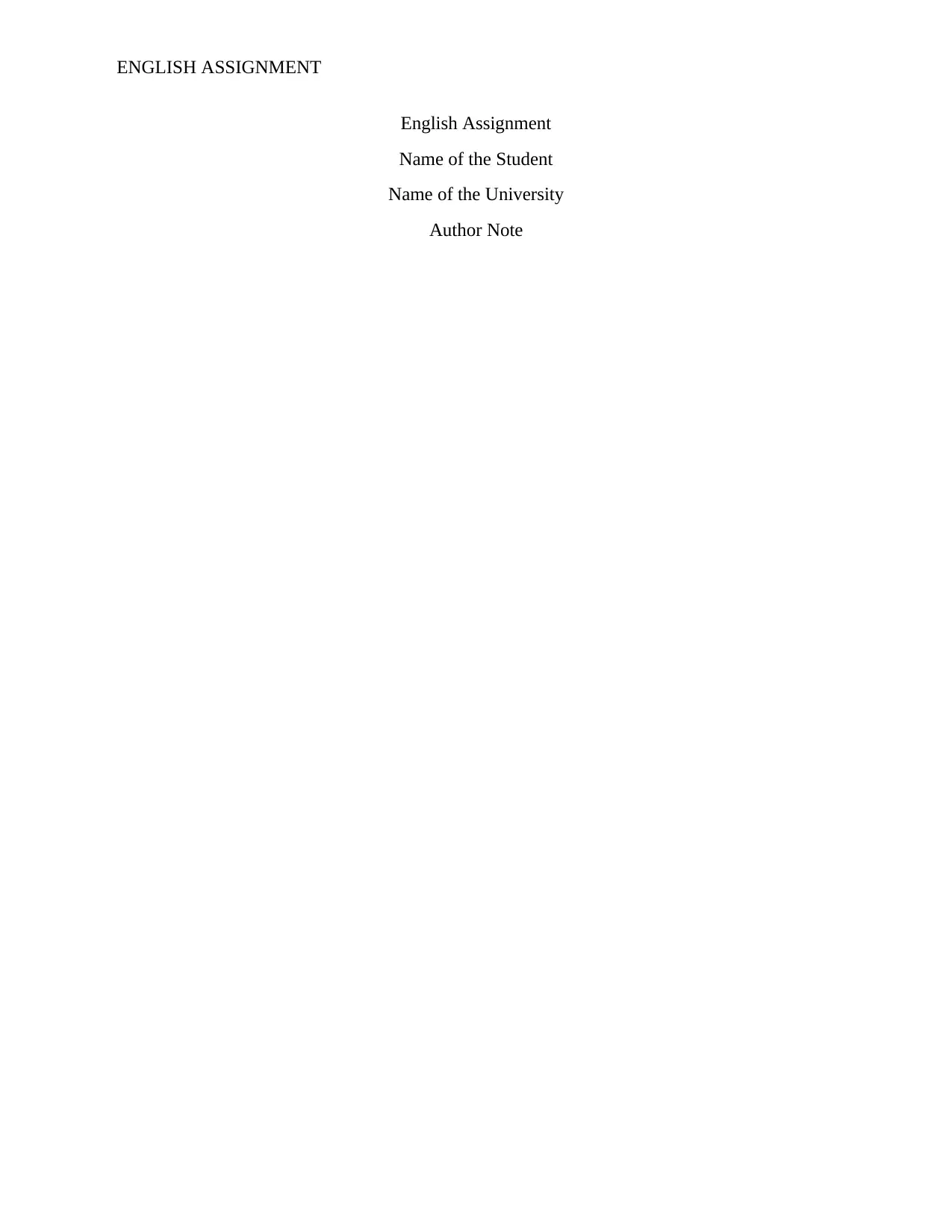
ENGLISH ASSIGNMENT
English Assignment
Name of the Student
Name of the University
Author Note
English Assignment
Name of the Student
Name of the University
Author Note
Paraphrase This Document
Need a fresh take? Get an instant paraphrase of this document with our AI Paraphraser
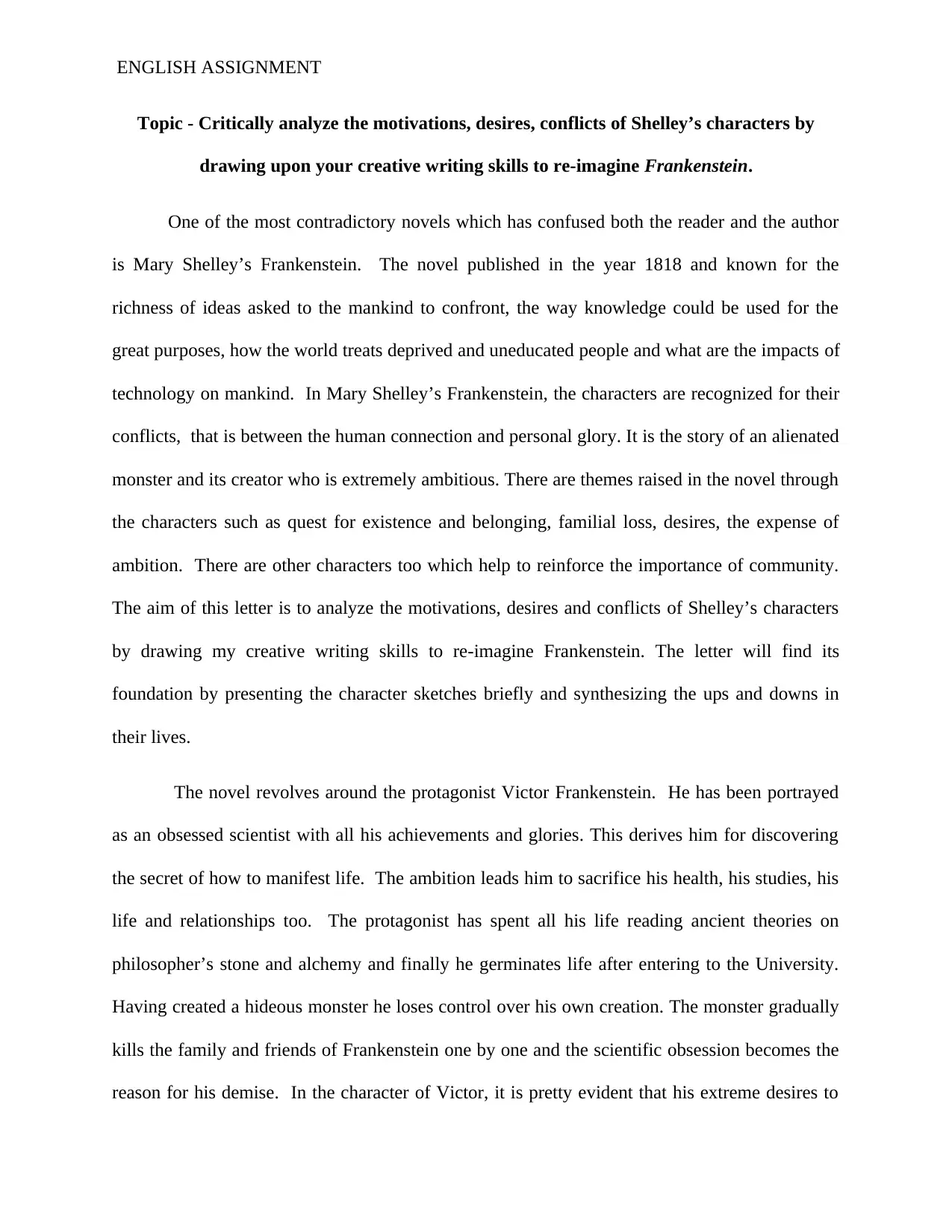
ENGLISH ASSIGNMENT
Topic - Critically analyze the motivations, desires, conflicts of Shelley’s characters by
drawing upon your creative writing skills to re-imagine Frankenstein.
One of the most contradictory novels which has confused both the reader and the author
is Mary Shelley’s Frankenstein. The novel published in the year 1818 and known for the
richness of ideas asked to the mankind to confront, the way knowledge could be used for the
great purposes, how the world treats deprived and uneducated people and what are the impacts of
technology on mankind. In Mary Shelley’s Frankenstein, the characters are recognized for their
conflicts, that is between the human connection and personal glory. It is the story of an alienated
monster and its creator who is extremely ambitious. There are themes raised in the novel through
the characters such as quest for existence and belonging, familial loss, desires, the expense of
ambition. There are other characters too which help to reinforce the importance of community.
The aim of this letter is to analyze the motivations, desires and conflicts of Shelley’s characters
by drawing my creative writing skills to re-imagine Frankenstein. The letter will find its
foundation by presenting the character sketches briefly and synthesizing the ups and downs in
their lives.
The novel revolves around the protagonist Victor Frankenstein. He has been portrayed
as an obsessed scientist with all his achievements and glories. This derives him for discovering
the secret of how to manifest life. The ambition leads him to sacrifice his health, his studies, his
life and relationships too. The protagonist has spent all his life reading ancient theories on
philosopher’s stone and alchemy and finally he germinates life after entering to the University.
Having created a hideous monster he loses control over his own creation. The monster gradually
kills the family and friends of Frankenstein one by one and the scientific obsession becomes the
reason for his demise. In the character of Victor, it is pretty evident that his extreme desires to
Topic - Critically analyze the motivations, desires, conflicts of Shelley’s characters by
drawing upon your creative writing skills to re-imagine Frankenstein.
One of the most contradictory novels which has confused both the reader and the author
is Mary Shelley’s Frankenstein. The novel published in the year 1818 and known for the
richness of ideas asked to the mankind to confront, the way knowledge could be used for the
great purposes, how the world treats deprived and uneducated people and what are the impacts of
technology on mankind. In Mary Shelley’s Frankenstein, the characters are recognized for their
conflicts, that is between the human connection and personal glory. It is the story of an alienated
monster and its creator who is extremely ambitious. There are themes raised in the novel through
the characters such as quest for existence and belonging, familial loss, desires, the expense of
ambition. There are other characters too which help to reinforce the importance of community.
The aim of this letter is to analyze the motivations, desires and conflicts of Shelley’s characters
by drawing my creative writing skills to re-imagine Frankenstein. The letter will find its
foundation by presenting the character sketches briefly and synthesizing the ups and downs in
their lives.
The novel revolves around the protagonist Victor Frankenstein. He has been portrayed
as an obsessed scientist with all his achievements and glories. This derives him for discovering
the secret of how to manifest life. The ambition leads him to sacrifice his health, his studies, his
life and relationships too. The protagonist has spent all his life reading ancient theories on
philosopher’s stone and alchemy and finally he germinates life after entering to the University.
Having created a hideous monster he loses control over his own creation. The monster gradually
kills the family and friends of Frankenstein one by one and the scientific obsession becomes the
reason for his demise. In the character of Victor, it is pretty evident that his extreme desires to
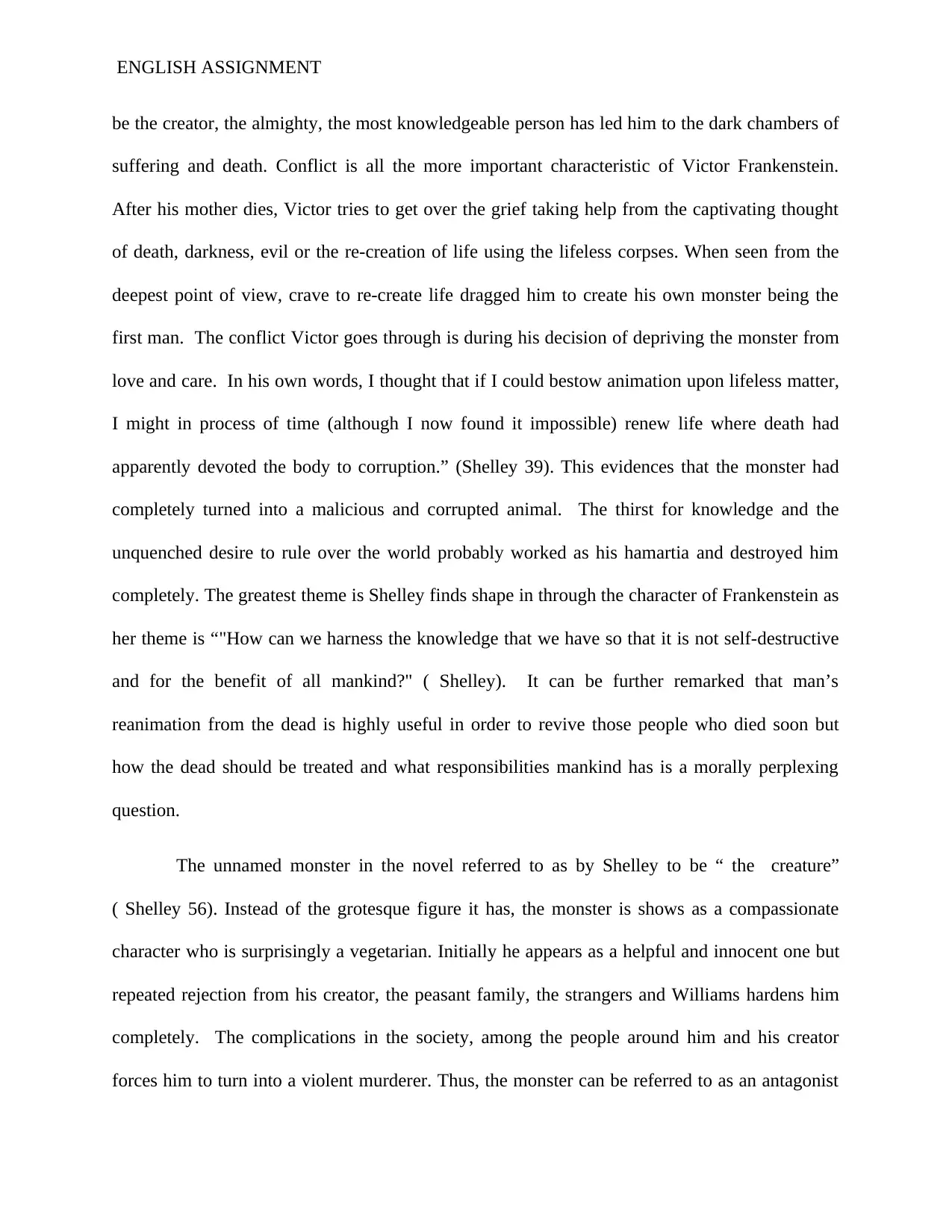
ENGLISH ASSIGNMENT
be the creator, the almighty, the most knowledgeable person has led him to the dark chambers of
suffering and death. Conflict is all the more important characteristic of Victor Frankenstein.
After his mother dies, Victor tries to get over the grief taking help from the captivating thought
of death, darkness, evil or the re-creation of life using the lifeless corpses. When seen from the
deepest point of view, crave to re-create life dragged him to create his own monster being the
first man. The conflict Victor goes through is during his decision of depriving the monster from
love and care. In his own words, I thought that if I could bestow animation upon lifeless matter,
I might in process of time (although I now found it impossible) renew life where death had
apparently devoted the body to corruption.” (Shelley 39). This evidences that the monster had
completely turned into a malicious and corrupted animal. The thirst for knowledge and the
unquenched desire to rule over the world probably worked as his hamartia and destroyed him
completely. The greatest theme is Shelley finds shape in through the character of Frankenstein as
her theme is “"How can we harness the knowledge that we have so that it is not self-destructive
and for the benefit of all mankind?" ( Shelley). It can be further remarked that man’s
reanimation from the dead is highly useful in order to revive those people who died soon but
how the dead should be treated and what responsibilities mankind has is a morally perplexing
question.
The unnamed monster in the novel referred to as by Shelley to be “ the creature”
( Shelley 56). Instead of the grotesque figure it has, the monster is shows as a compassionate
character who is surprisingly a vegetarian. Initially he appears as a helpful and innocent one but
repeated rejection from his creator, the peasant family, the strangers and Williams hardens him
completely. The complications in the society, among the people around him and his creator
forces him to turn into a violent murderer. Thus, the monster can be referred to as an antagonist
be the creator, the almighty, the most knowledgeable person has led him to the dark chambers of
suffering and death. Conflict is all the more important characteristic of Victor Frankenstein.
After his mother dies, Victor tries to get over the grief taking help from the captivating thought
of death, darkness, evil or the re-creation of life using the lifeless corpses. When seen from the
deepest point of view, crave to re-create life dragged him to create his own monster being the
first man. The conflict Victor goes through is during his decision of depriving the monster from
love and care. In his own words, I thought that if I could bestow animation upon lifeless matter,
I might in process of time (although I now found it impossible) renew life where death had
apparently devoted the body to corruption.” (Shelley 39). This evidences that the monster had
completely turned into a malicious and corrupted animal. The thirst for knowledge and the
unquenched desire to rule over the world probably worked as his hamartia and destroyed him
completely. The greatest theme is Shelley finds shape in through the character of Frankenstein as
her theme is “"How can we harness the knowledge that we have so that it is not self-destructive
and for the benefit of all mankind?" ( Shelley). It can be further remarked that man’s
reanimation from the dead is highly useful in order to revive those people who died soon but
how the dead should be treated and what responsibilities mankind has is a morally perplexing
question.
The unnamed monster in the novel referred to as by Shelley to be “ the creature”
( Shelley 56). Instead of the grotesque figure it has, the monster is shows as a compassionate
character who is surprisingly a vegetarian. Initially he appears as a helpful and innocent one but
repeated rejection from his creator, the peasant family, the strangers and Williams hardens him
completely. The complications in the society, among the people around him and his creator
forces him to turn into a violent murderer. Thus, the monster can be referred to as an antagonist
⊘ This is a preview!⊘
Do you want full access?
Subscribe today to unlock all pages.

Trusted by 1+ million students worldwide
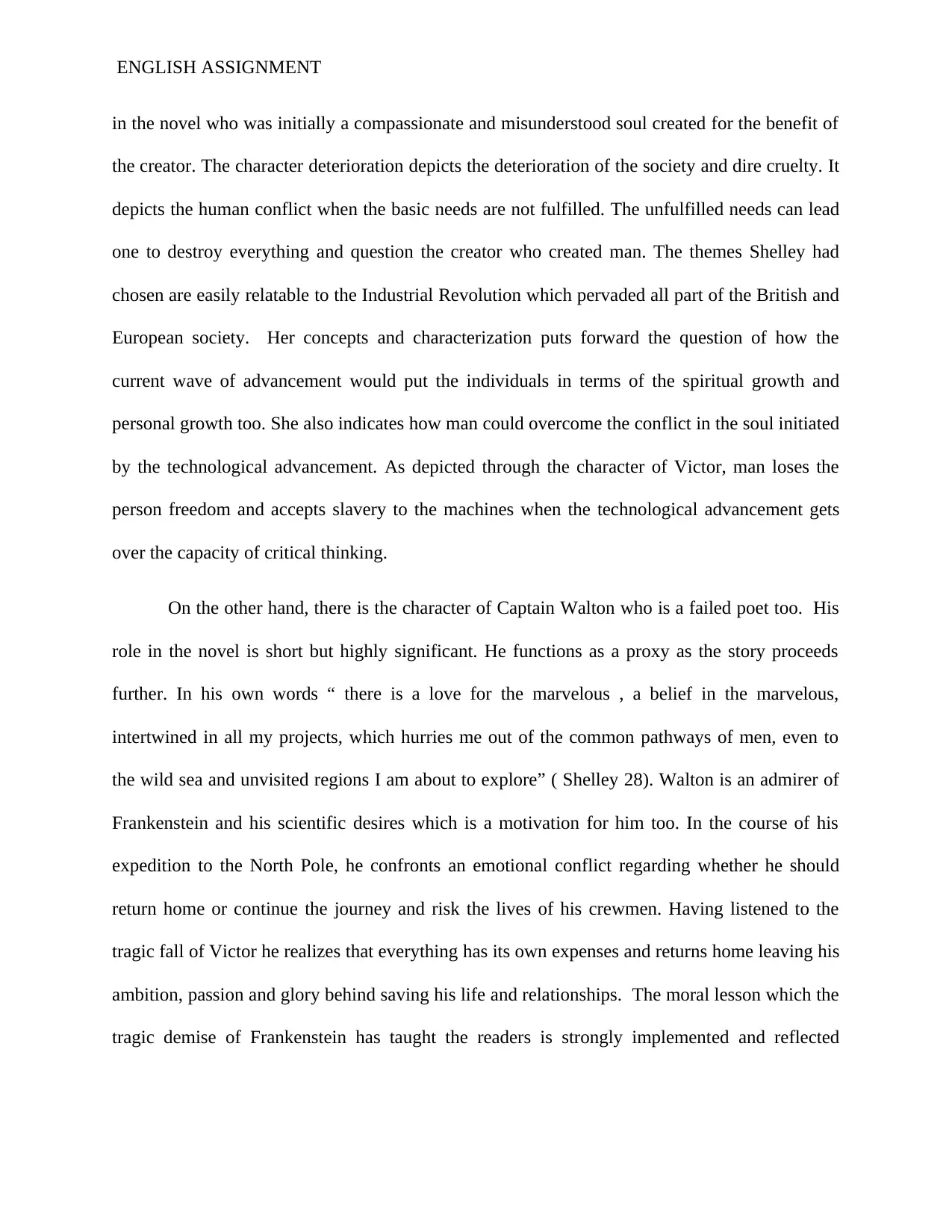
ENGLISH ASSIGNMENT
in the novel who was initially a compassionate and misunderstood soul created for the benefit of
the creator. The character deterioration depicts the deterioration of the society and dire cruelty. It
depicts the human conflict when the basic needs are not fulfilled. The unfulfilled needs can lead
one to destroy everything and question the creator who created man. The themes Shelley had
chosen are easily relatable to the Industrial Revolution which pervaded all part of the British and
European society. Her concepts and characterization puts forward the question of how the
current wave of advancement would put the individuals in terms of the spiritual growth and
personal growth too. She also indicates how man could overcome the conflict in the soul initiated
by the technological advancement. As depicted through the character of Victor, man loses the
person freedom and accepts slavery to the machines when the technological advancement gets
over the capacity of critical thinking.
On the other hand, there is the character of Captain Walton who is a failed poet too. His
role in the novel is short but highly significant. He functions as a proxy as the story proceeds
further. In his own words “ there is a love for the marvelous , a belief in the marvelous,
intertwined in all my projects, which hurries me out of the common pathways of men, even to
the wild sea and unvisited regions I am about to explore” ( Shelley 28). Walton is an admirer of
Frankenstein and his scientific desires which is a motivation for him too. In the course of his
expedition to the North Pole, he confronts an emotional conflict regarding whether he should
return home or continue the journey and risk the lives of his crewmen. Having listened to the
tragic fall of Victor he realizes that everything has its own expenses and returns home leaving his
ambition, passion and glory behind saving his life and relationships. The moral lesson which the
tragic demise of Frankenstein has taught the readers is strongly implemented and reflected
in the novel who was initially a compassionate and misunderstood soul created for the benefit of
the creator. The character deterioration depicts the deterioration of the society and dire cruelty. It
depicts the human conflict when the basic needs are not fulfilled. The unfulfilled needs can lead
one to destroy everything and question the creator who created man. The themes Shelley had
chosen are easily relatable to the Industrial Revolution which pervaded all part of the British and
European society. Her concepts and characterization puts forward the question of how the
current wave of advancement would put the individuals in terms of the spiritual growth and
personal growth too. She also indicates how man could overcome the conflict in the soul initiated
by the technological advancement. As depicted through the character of Victor, man loses the
person freedom and accepts slavery to the machines when the technological advancement gets
over the capacity of critical thinking.
On the other hand, there is the character of Captain Walton who is a failed poet too. His
role in the novel is short but highly significant. He functions as a proxy as the story proceeds
further. In his own words “ there is a love for the marvelous , a belief in the marvelous,
intertwined in all my projects, which hurries me out of the common pathways of men, even to
the wild sea and unvisited regions I am about to explore” ( Shelley 28). Walton is an admirer of
Frankenstein and his scientific desires which is a motivation for him too. In the course of his
expedition to the North Pole, he confronts an emotional conflict regarding whether he should
return home or continue the journey and risk the lives of his crewmen. Having listened to the
tragic fall of Victor he realizes that everything has its own expenses and returns home leaving his
ambition, passion and glory behind saving his life and relationships. The moral lesson which the
tragic demise of Frankenstein has taught the readers is strongly implemented and reflected
Paraphrase This Document
Need a fresh take? Get an instant paraphrase of this document with our AI Paraphraser
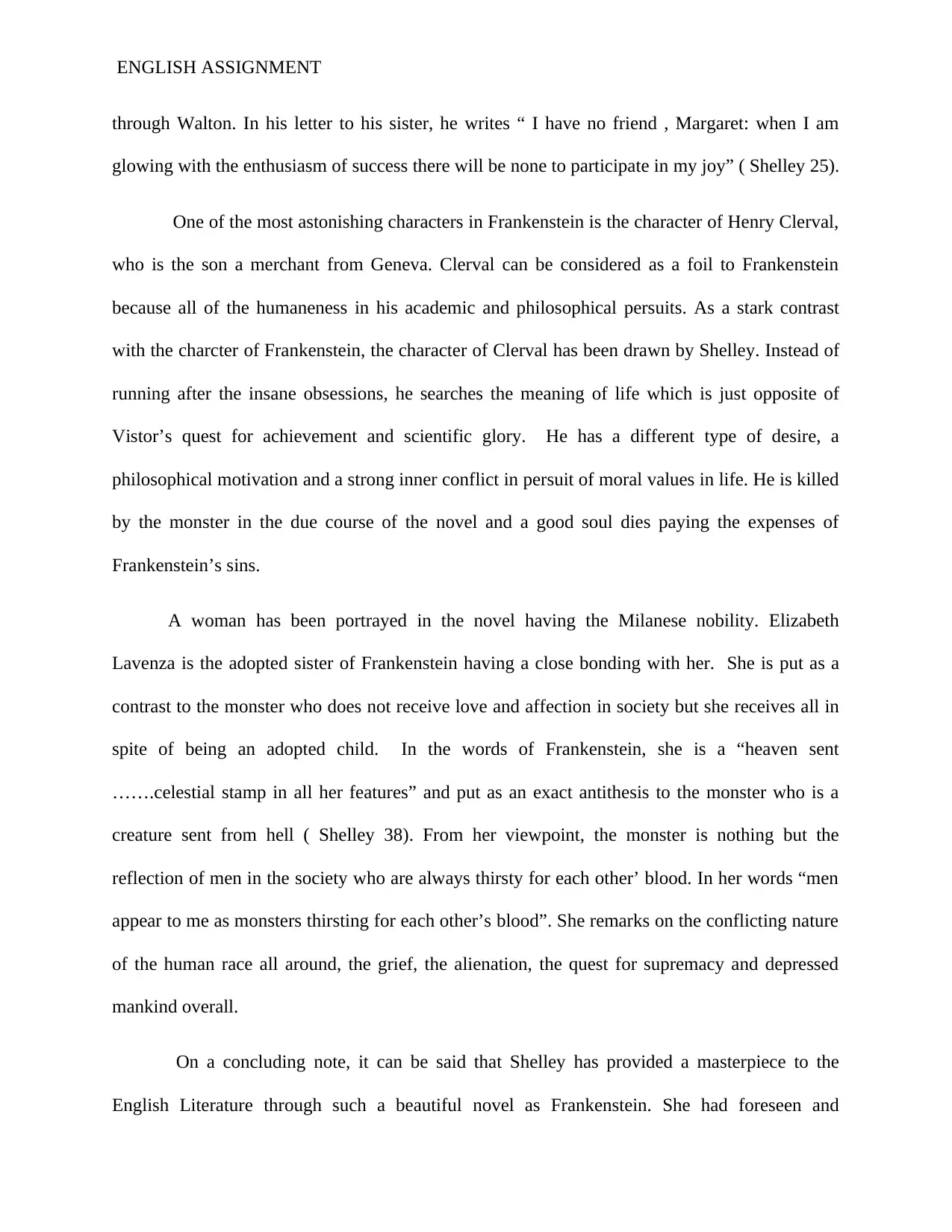
ENGLISH ASSIGNMENT
through Walton. In his letter to his sister, he writes “ I have no friend , Margaret: when I am
glowing with the enthusiasm of success there will be none to participate in my joy” ( Shelley 25).
One of the most astonishing characters in Frankenstein is the character of Henry Clerval,
who is the son a merchant from Geneva. Clerval can be considered as a foil to Frankenstein
because all of the humaneness in his academic and philosophical persuits. As a stark contrast
with the charcter of Frankenstein, the character of Clerval has been drawn by Shelley. Instead of
running after the insane obsessions, he searches the meaning of life which is just opposite of
Vistor’s quest for achievement and scientific glory. He has a different type of desire, a
philosophical motivation and a strong inner conflict in persuit of moral values in life. He is killed
by the monster in the due course of the novel and a good soul dies paying the expenses of
Frankenstein’s sins.
A woman has been portrayed in the novel having the Milanese nobility. Elizabeth
Lavenza is the adopted sister of Frankenstein having a close bonding with her. She is put as a
contrast to the monster who does not receive love and affection in society but she receives all in
spite of being an adopted child. In the words of Frankenstein, she is a “heaven sent
…….celestial stamp in all her features” and put as an exact antithesis to the monster who is a
creature sent from hell ( Shelley 38). From her viewpoint, the monster is nothing but the
reflection of men in the society who are always thirsty for each other’ blood. In her words “men
appear to me as monsters thirsting for each other’s blood”. She remarks on the conflicting nature
of the human race all around, the grief, the alienation, the quest for supremacy and depressed
mankind overall.
On a concluding note, it can be said that Shelley has provided a masterpiece to the
English Literature through such a beautiful novel as Frankenstein. She had foreseen and
through Walton. In his letter to his sister, he writes “ I have no friend , Margaret: when I am
glowing with the enthusiasm of success there will be none to participate in my joy” ( Shelley 25).
One of the most astonishing characters in Frankenstein is the character of Henry Clerval,
who is the son a merchant from Geneva. Clerval can be considered as a foil to Frankenstein
because all of the humaneness in his academic and philosophical persuits. As a stark contrast
with the charcter of Frankenstein, the character of Clerval has been drawn by Shelley. Instead of
running after the insane obsessions, he searches the meaning of life which is just opposite of
Vistor’s quest for achievement and scientific glory. He has a different type of desire, a
philosophical motivation and a strong inner conflict in persuit of moral values in life. He is killed
by the monster in the due course of the novel and a good soul dies paying the expenses of
Frankenstein’s sins.
A woman has been portrayed in the novel having the Milanese nobility. Elizabeth
Lavenza is the adopted sister of Frankenstein having a close bonding with her. She is put as a
contrast to the monster who does not receive love and affection in society but she receives all in
spite of being an adopted child. In the words of Frankenstein, she is a “heaven sent
…….celestial stamp in all her features” and put as an exact antithesis to the monster who is a
creature sent from hell ( Shelley 38). From her viewpoint, the monster is nothing but the
reflection of men in the society who are always thirsty for each other’ blood. In her words “men
appear to me as monsters thirsting for each other’s blood”. She remarks on the conflicting nature
of the human race all around, the grief, the alienation, the quest for supremacy and depressed
mankind overall.
On a concluding note, it can be said that Shelley has provided a masterpiece to the
English Literature through such a beautiful novel as Frankenstein. She had foreseen and
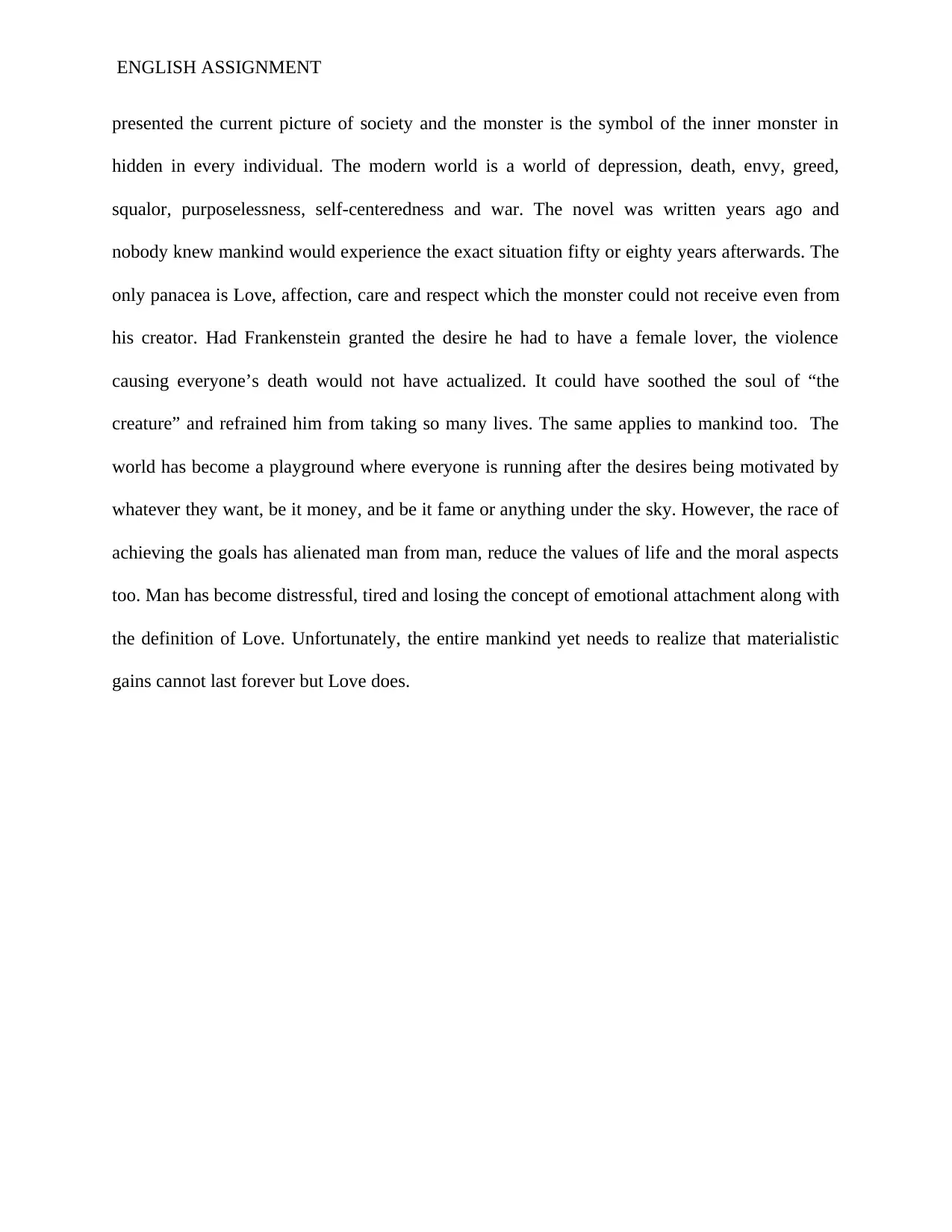
ENGLISH ASSIGNMENT
presented the current picture of society and the monster is the symbol of the inner monster in
hidden in every individual. The modern world is a world of depression, death, envy, greed,
squalor, purposelessness, self-centeredness and war. The novel was written years ago and
nobody knew mankind would experience the exact situation fifty or eighty years afterwards. The
only panacea is Love, affection, care and respect which the monster could not receive even from
his creator. Had Frankenstein granted the desire he had to have a female lover, the violence
causing everyone’s death would not have actualized. It could have soothed the soul of “the
creature” and refrained him from taking so many lives. The same applies to mankind too. The
world has become a playground where everyone is running after the desires being motivated by
whatever they want, be it money, and be it fame or anything under the sky. However, the race of
achieving the goals has alienated man from man, reduce the values of life and the moral aspects
too. Man has become distressful, tired and losing the concept of emotional attachment along with
the definition of Love. Unfortunately, the entire mankind yet needs to realize that materialistic
gains cannot last forever but Love does.
presented the current picture of society and the monster is the symbol of the inner monster in
hidden in every individual. The modern world is a world of depression, death, envy, greed,
squalor, purposelessness, self-centeredness and war. The novel was written years ago and
nobody knew mankind would experience the exact situation fifty or eighty years afterwards. The
only panacea is Love, affection, care and respect which the monster could not receive even from
his creator. Had Frankenstein granted the desire he had to have a female lover, the violence
causing everyone’s death would not have actualized. It could have soothed the soul of “the
creature” and refrained him from taking so many lives. The same applies to mankind too. The
world has become a playground where everyone is running after the desires being motivated by
whatever they want, be it money, and be it fame or anything under the sky. However, the race of
achieving the goals has alienated man from man, reduce the values of life and the moral aspects
too. Man has become distressful, tired and losing the concept of emotional attachment along with
the definition of Love. Unfortunately, the entire mankind yet needs to realize that materialistic
gains cannot last forever but Love does.
⊘ This is a preview!⊘
Do you want full access?
Subscribe today to unlock all pages.

Trusted by 1+ million students worldwide
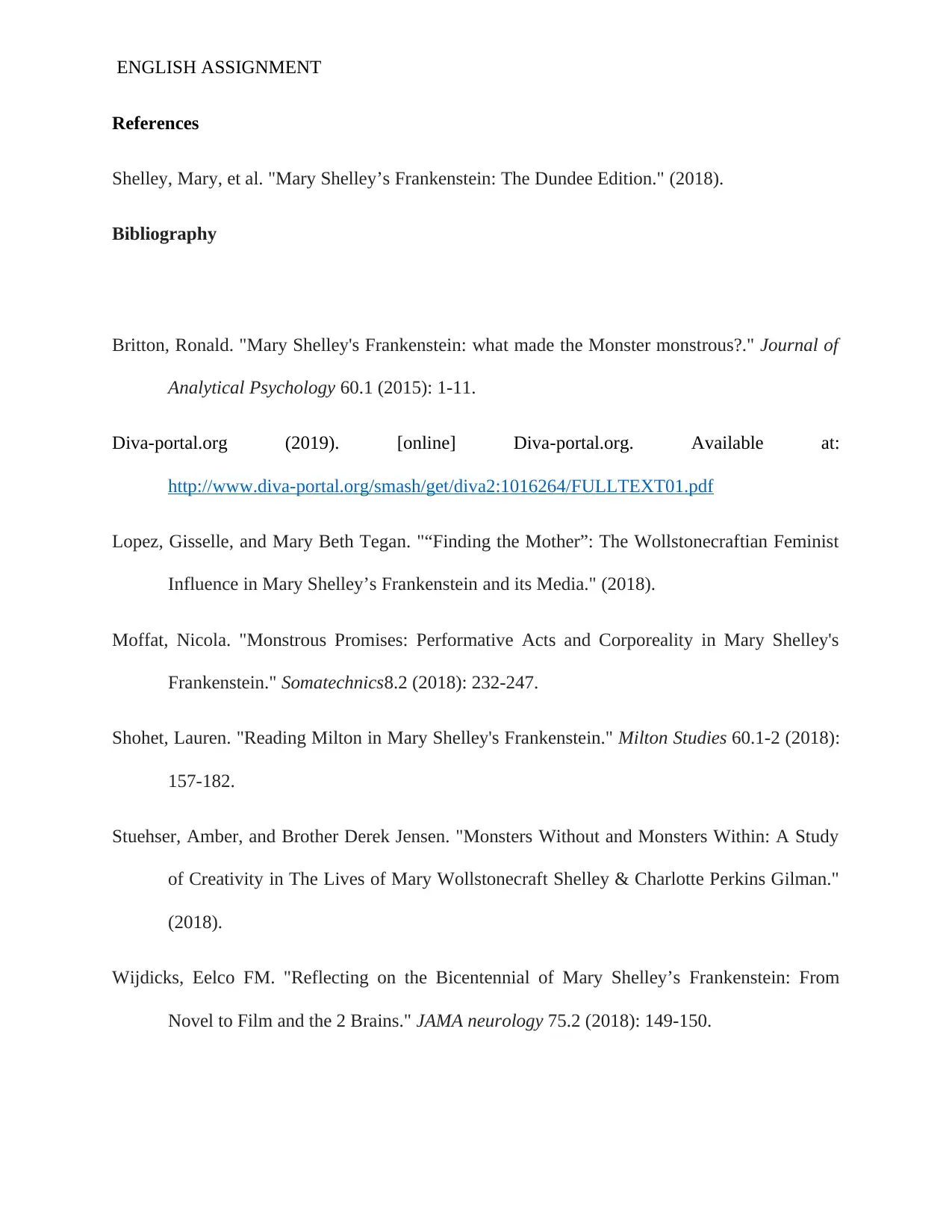
ENGLISH ASSIGNMENT
References
Shelley, Mary, et al. "Mary Shelley’s Frankenstein: The Dundee Edition." (2018).
Bibliography
Britton, Ronald. "Mary Shelley's Frankenstein: what made the Monster monstrous?." Journal of
Analytical Psychology 60.1 (2015): 1-11.
Diva-portal.org (2019). [online] Diva-portal.org. Available at:
http://www.diva-portal.org/smash/get/diva2:1016264/FULLTEXT01.pdf
Lopez, Gisselle, and Mary Beth Tegan. "“Finding the Mother”: The Wollstonecraftian Feminist
Influence in Mary Shelley’s Frankenstein and its Media." (2018).
Moffat, Nicola. "Monstrous Promises: Performative Acts and Corporeality in Mary Shelley's
Frankenstein." Somatechnics8.2 (2018): 232-247.
Shohet, Lauren. "Reading Milton in Mary Shelley's Frankenstein." Milton Studies 60.1-2 (2018):
157-182.
Stuehser, Amber, and Brother Derek Jensen. "Monsters Without and Monsters Within: A Study
of Creativity in The Lives of Mary Wollstonecraft Shelley & Charlotte Perkins Gilman."
(2018).
Wijdicks, Eelco FM. "Reflecting on the Bicentennial of Mary Shelley’s Frankenstein: From
Novel to Film and the 2 Brains." JAMA neurology 75.2 (2018): 149-150.
References
Shelley, Mary, et al. "Mary Shelley’s Frankenstein: The Dundee Edition." (2018).
Bibliography
Britton, Ronald. "Mary Shelley's Frankenstein: what made the Monster monstrous?." Journal of
Analytical Psychology 60.1 (2015): 1-11.
Diva-portal.org (2019). [online] Diva-portal.org. Available at:
http://www.diva-portal.org/smash/get/diva2:1016264/FULLTEXT01.pdf
Lopez, Gisselle, and Mary Beth Tegan. "“Finding the Mother”: The Wollstonecraftian Feminist
Influence in Mary Shelley’s Frankenstein and its Media." (2018).
Moffat, Nicola. "Monstrous Promises: Performative Acts and Corporeality in Mary Shelley's
Frankenstein." Somatechnics8.2 (2018): 232-247.
Shohet, Lauren. "Reading Milton in Mary Shelley's Frankenstein." Milton Studies 60.1-2 (2018):
157-182.
Stuehser, Amber, and Brother Derek Jensen. "Monsters Without and Monsters Within: A Study
of Creativity in The Lives of Mary Wollstonecraft Shelley & Charlotte Perkins Gilman."
(2018).
Wijdicks, Eelco FM. "Reflecting on the Bicentennial of Mary Shelley’s Frankenstein: From
Novel to Film and the 2 Brains." JAMA neurology 75.2 (2018): 149-150.
1 out of 7
Related Documents
Your All-in-One AI-Powered Toolkit for Academic Success.
+13062052269
info@desklib.com
Available 24*7 on WhatsApp / Email
![[object Object]](/_next/static/media/star-bottom.7253800d.svg)
Unlock your academic potential
Copyright © 2020–2025 A2Z Services. All Rights Reserved. Developed and managed by ZUCOL.





